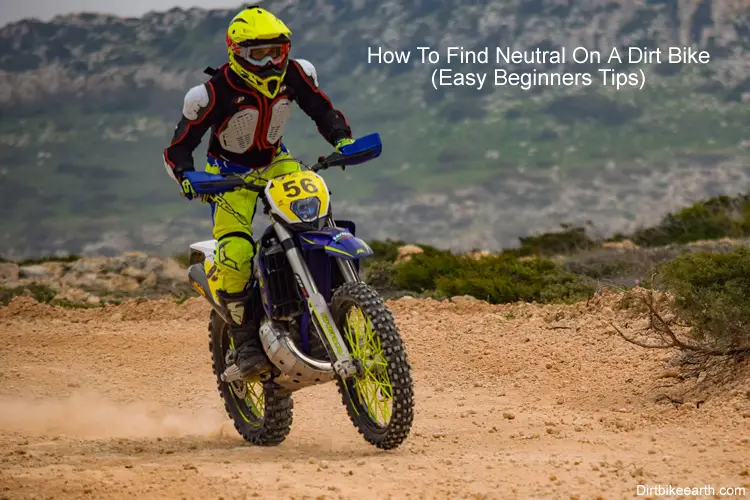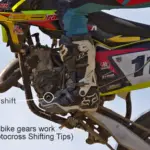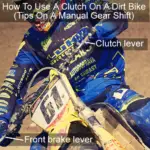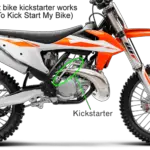
Finding neutral on a dirt bike is not easy for beginners, but here’s how it’s done
I remember my first time on a motorbike finding it tough to find neutral on a bike with gears. But the bike was an old one too and the gear box was well used, which didn’t help. This article is about how to find neutral on a dirt bike for beginners.
So how to find neutral on a dirt bike? Neutral on a dirt bike is between first gear and second gear. The trick is to kick down on the gear shift several times to select first gear. Then put your foot under the gear shift to lift it for the slightest of clicks up into neutral. If you feel a significant click you’ll have selected second gear instead.
What is neutral on a dirt bike?
Just in case you’re reading this and you are very new to motorbiking, and in particular to dirt biking, this section explains what neutral is.
If you are a car driver and you’re used to driving an automatic car, neutral is a whole new concept to you. An automatic doesn’t have a neutral gear as such.
So what is neutral? Neutral is when the gear box disengages the internal cogs from the part that drives the cog and chain linked to the back wheel of your dirt bike. When neutral is selected and the engine is running, there will be no power to the back wheel.
To compare this to an automatic, its similar to having your car in ‘park’ mode or in ‘drive,’ but when you don’t press the accelerator down. The car will idle but will not move.
Why does a dirt bike need neutral and what is the neutral gear for?
A dirt bike needs neutral for when you start the bike. Neutral is also used when you stop and want to leave the engine running, but without having to hold the clutch in.
Using the neutral gear can be bypassed by using the clutch. But it’s better to select neutral, especially as a beginner dirt bike rider. Learning this skill and practicing selecting neutral is all part of learning to ride a dirt bike well.
When you start your dirt bike, either using the electric start or with the kick start, the last thing you want is for the gear box to be engaged. If it were when you tried to start the bike, it would lurch forward (except if you have the clutch pulled in).
As already mentioned this can be by passed using the clutch. By pulling the clutch in all of the way, you don’t need to select neutral, as this has the same effect on the gear box.
When the clutch is depressed on a motorbike (which is the same for a stick shift car), this disengages the engines drive from the gears and stops any power going to the rear wheel, just like it’s in neutral.
Where is neutral on a dirt bike?
Neutral on a dirt bike is in between first gear and second gear. It’s not always easy to find as a first time dirt bike rider either.
So if you are finding it difficult to find neutral, don’t worry, as you are not alone. This is one of the hardest things for many newbie dirt bike riders.
The simple trick to finding neutral on a dirt bike beginners should know
As already explained, neutral is between first gear and second gear.
Most dirt bikes have five gears in total (some have six). First gear is selected by pressing down on the gear shift lever, which is just in front of the left foot peg. It’s always a good trick to press it down at least five times with your foot. This way if you were in fifth gear to begin with, you at least know that it’s now going to be in first gear.
To get into second gear, you then need to put your foot under the gear shift lever and lift it up. This should be a notable click, one that is similar to when you clicked down into first gear. Or alternatively, if you try clicking up another time into third gear, this should feel the same as clicking into second gear.
But neutral is in between first and second. So instead of going for a full upward push and click into second gear, go for a slight nudge instead. This should feel and sound totally different to a complete gear change.
Practice this a few times, first by trying to push up hard and going into second gear. Get used to the feel and sound of a full click. Then try a slight nudged and into neutral. Get a feel for what neutral sounds and is like. After a few attempts at this you will begin to feel the difference, as your foot senses the smaller movement into neutral.
How to know you’re in neutral gear
Some dirt bikes have a neutral light. If your bike has a neutral light, this will help you when practicing, as this will confirm each time you properly engage neutral gear. But if you don’t have a neutral light there are two ways to check if you’ve managed to select it.
Ways to check if your dirt bike is in neutral gear without a neutral light
If your dirt bike doesn’t have a neutral light, the easiest way to check when neutral is selected with the engine switch off is to try rolling your bike backwards and forwards. Do this with your feet either side of the bike and planted on the ground. Make sure you don’t have your hand on the front brake lever on the right handle bar.
Also, make sure you’ve not pulled the clutch in, as this will provide the same effect as putting your bike into neutral.
If when you try to roll the bike back and forth you encounter resistance, this means the bike is still in gear. This is either still in first gear or you’ve moved too far and up into second gear.
If this is the case, click the gear shift lever down to first gear and try again. Just in case, try clicking it down a couple of times. This will make sure your bike is in first gear.
Checking neutral with the engine running
The other way to find out if your dirt bike is in neutral or not is to do this with the engine running. First you will need to pull the clutch in on the left handle bar. Then, using the same process as explained above by first clicking all the way down into first gear, try for a small nudge up into neutral.
Secondly, once you think the bike is in neutral, slowly let out the clutch. As the clutch lever gets to what would be the ‘bite-point,’ but where nothing happens, you have found neutral. If however, as you slowly release the clutch and you feel the engine start to bite, whilst at the same time the revs begin to drop, you have likely shifted up into second gear.
This second method is more challenging for beginners, but it’s good practice for letting the clutch out.
The order of gears on a dirt bike
The order of gears on most dirt bikes is as follows:
- 1st gear
- Neutral
- 2nd gear
- 3rd gear
- 4th gear
- 5th gear
- 6th gear (on some dirt bikes)
Some dirt bikes don’t have gears as list above. These include ones with an automatic gear box or centrifugal clutch. These are the type of gear boxes on kids 50cc or 110cc dirt bikes.
There are a few specialist race bikes that have neutral at the bottom of the gear shift selector too.
Why is neutral between first and second gear and not at the bottom?
If would seem to make more sense to have neutral as the bottom-most gear. So why is neutral between first gear and second gear and not at the bottom?
This is more historical than anything else and relates to road bikes. Imagine being on a road bike and arriving at a set of traffic lights. If neutral were at the bottom, bikers would tend to push the gears all the way down and instead of being in first gear, they’d be in neutral. It is therefore much easier to have first gear as the very bottom gear. This way it was easier to know when first gear is selected.
The other important reason is if you are slowing down rapidly for a turn or corner and you want to be in first gear through and accelerating out of the corner, you may select neutral by mistake. If neutral were at the bottom, it would be very easy to select it, which wouldn’t be good when going into a corner. As this is one of the most important times to have continuous drive to the rear wheel when going around a corner.
What happens if I select neutral when I’m riding along on my dirt bike?
Don’t worry if you happen to select neutral by mistake when you’re riding along on your dirt bike. This happens to the best of us. Don’t be at all surprised if this happens more often when you’re a beginner. Also, it’s more likely to happen when you’re tired or fatigued too.
You will soon know if you’re in neutral, because when you release the clutch and open up the throttle again, your engine will over-rev. As the engine is not engaged to the back wheel and there’s no drive for the engine and it will simply rev.
This is easily fixed. Push the throttle back, pull the clutch back in and re-click the gear lever up into second gear. Then try letting the clutch out and putting some throttle on and this time hopefully you’ll have engaged second gear, instead of neutral.
How to avoid using neutral gear on a dirt bike altogether
As a beginner dirt bike rider there are many things to learn and master. Although I recommend you start early to master discovering neutral, you don’t have to do this right away.
The main reason for neutral is for starting your dirt bike and stopping again. The same objective can be achieved by using the clutch instead.
When you start your bike, pull the clutch in all the way. This will disengage the engine from the gear box. Which means there’ll be no drive to the rear wheel. Just like your bike is in neutral.
Start your bike in the usual way, either using the electric start or by using the kick start. Once started, you can move away by releasing the clutch slowly and applying the throttle at the same time.
Similarly, when you come to a standstill, instead of trying to find neutral, simply hold the clutch in. However, to leave your bike, you will need to switch the engine off before you release the clutch, otherwise your bike will lurch forward and stall.
Why can’t I select neutral on my dirt bike?
If you’re having difficulty selecting neutral on your dirt bike after following this guide, you may have a gear box problem. It may be that the dirt bike you’ve purchase is second hand, it may be the bike has taken a hammering on the tracks and off-road.
If this is the case and perhaps the rider drove it hard and didn’t use the clutch to change gear, the gear box may need replacing or an overhaul.
You may need to take your bike into you local bike dealer to have them check it over. Hopefully it may just be down to how you are attempting to select neutral, but it shouldn’t be if you’ve followed how I’ve explained it above.
It maybe the gear box needs more oil or an oil change to help better lubricate the cogs and gear change mechanism, looking on the bight side. But if it’s not down to your technique or an oil change, you may be looking at a higher cost of a new gear box.
You may be able to source a second hand gear box. But you will still need to find someone to fit it for you.
I hope you enjoyed this article about how to find neutral on a dirt bike
I’d love to hear from you. Tell us about your adventures of dirt biking in the comments below. Please also share your photos. Either from your cameras or videos from your Gopro’s!
If this article hasn’t answered all of your questions. If you have more questions about dirt biking (or specifically about how to find neutral on a dirt bike), please comment below with your questions.
There will also be many more articles about dirt biking for you to read and learn about this fabulous sport and hobby.
Have fun and be safe!



